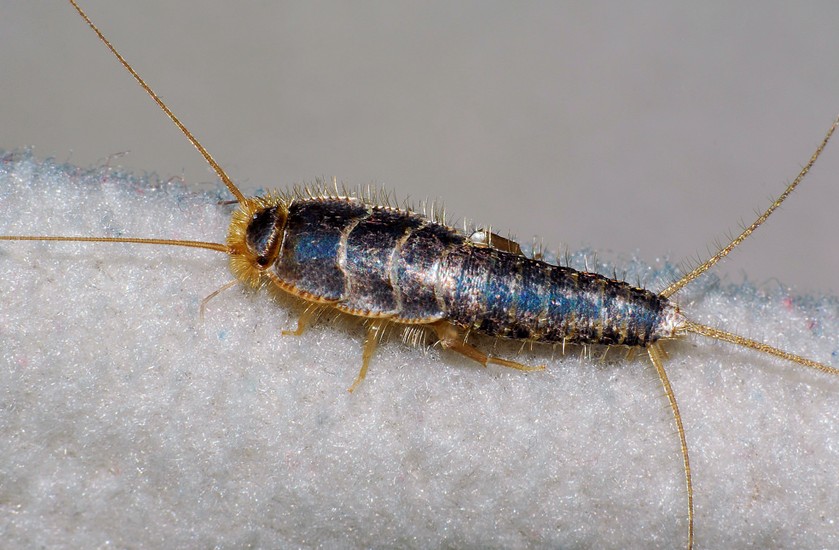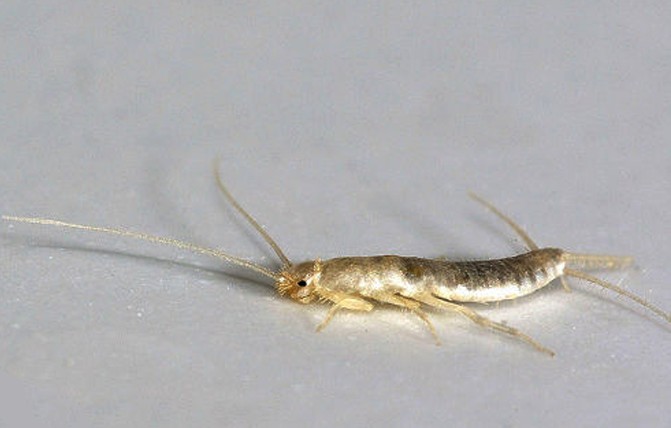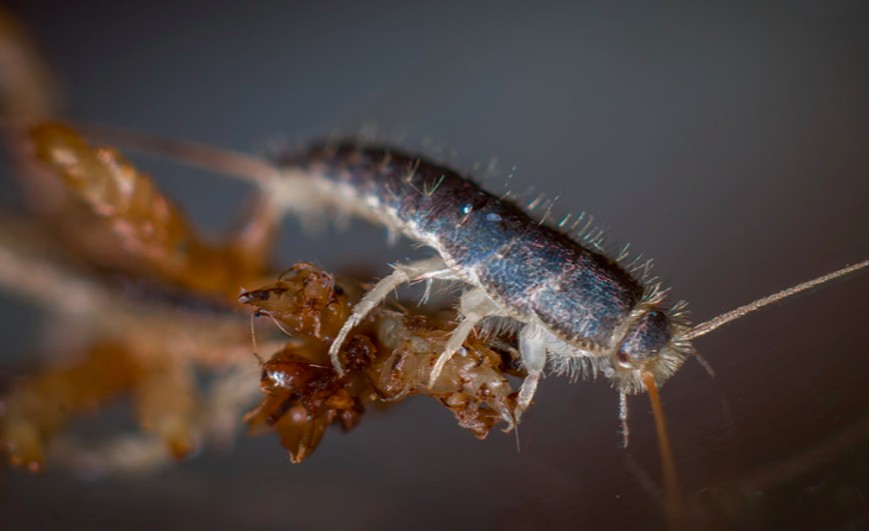Silverfish
What are Silverfish?
No, they have got nothing to do with marine life. These are tiny insects that can be found in the warm and dark places of your home, like the ovens, dryer for your clothes, furnaces, fireplaces, and furnaces. Silverfish have a very distinctive shape. They appear to be very tapered and flat. One can’t miss out the color of the Silverfish that is a combination of silver and gray; it also has a weird three-headed kind of tail.
Silverfish show their interest in starchy substances that are found in pantries. Not to mention their love for old books. They invade libraries and love to consume the printing material. Their harmless nature continues to be a nuisance for humans.
Identification

Picture of a Silverfish
Silverfish or Lepisma Saccharina (species name) is a nocturnal insect that grows from 13 mm to 25 mm in length. They have a fish like tapered appearance, which had earned them their name. The young Silverfish are white in color, and as they grow old, they develop a tinge of silver on themselves which makes their body shine.
Silverfish have a filament and two cerci that are very long. Between the right and the left cerci, they have terminal filament which projects from the end portion of their body. They are not eyeless like other insects from their order. Silverfish has two compound black eyes.
They have absolutely no wings and come with a pair of very long antennae. Silverfish moves around in a wiggling, fish-like motion. Apart from this, they have silver scales on their body which makes them all the more fish-like in appearance. Silverfish are known for their running abilities and can outrun most of its predators. They hate too much light and stay as far as possible from it.
Where are Silverfish found?
A silverfish has a cosmopolitan distribution, which means they can be found in all most every habitat of the world. From Africa to Australia, America, Eurasia, and the Pacifics. They love to reside in moist and places with high humidity. In cities, they can be found in homes especially in basements, attics, old books, bathtubs, showers, sinks, and kitchen.
In their natural habitats, Silverfish commonly hides under leaf litter, logs, rocks, and in the form of naturally occurring crevices. They love to live in places that have 70 ° – 80° temperature.
Reproduction and Life Cycle
During the mating process, the male Silverfish places its sperms on silk threads. The female Silverfish goes and picks it up. Then, the female Silverfish lays its eggs in crevices, cracks, and other hidden places. When the temperature is within 22°C to 27°C, the female Silverfish lays as many as 100 eggs. This is an approximate of the number of eggs they lay in their entire lifetime.
At a time, they will lay a maximum of three eggs, but they continue to lay eggs throughout the week. The eggs hatch, depending on favorable weather conditions. It usually takes three weeks, but it can also exceed up to a maximum of six weeks. There is no fixed time for a Silverfish to lay eggs. They find secluded and dark places for example closets, bookshelves, and so on to lay their eggs.
The female Silverfish lays whitish and oval-shaped eggs which grow as long as 0.8mm. The nymph is whitish in color and looks exactly like its adult version. As they grow, the young Silverfish starts gaining a tinge of grey, which gives them a metallic shine and greyish appearance.
A Silverfish goes through as many as 66 moults in their lifetime. They continue to moult even after they have reached their adulthood.
Pictures of Silverfish
Take a close look at some of these fascinating pictures of silverfish:



What does a Silverfish eat?
Silverfish love to eat plant parts because they get their protein and carbohydrates from it. They can eat anything, and that comprises of glue, book bindings, wallpaper, photographs, paper, linen, cotton, clothing, and fabric. Silverfish can even eat through the organic as well as non-organic material. They enjoy flour, cereal, and even sugar.
How harmful are Silverfish?
Silverfish don’t have the power to bite or sting humans. They will never do it even if they are threatened. Silverfish doesn’t consume blood; they will feast on the starch, carbohydrates, and sugar present in your home. They can even dine on wood and different types of wooden products. Yes, Silverfish don’t bite or spread diseases, however, they have a lot of love for dandruff. They will crawl in your bed while you are enjoying your slumber to consume that dandruff from your head. Just imagine a cockroach-like insect with a lot of resemblance to fishes, in your bed. They can even be in your hairbrush. None of which is preferable.
Silverfish don’t harm wood like that of termites or the carpenter ants. But, they will eat your wallpaper, old photos, silk, linen, cotton, synthetic and natural fibers, as well as leather wear. They will also eat your drapes, sheets, and blankets. Nothing is safe from the clutches of a silverfish. These insects can ruin your pantry, clothes, books, photos, and in short everything. They are a complete nuisance and one of the worst creatures to live with.
Ways to Get Rid of Silverfish Invasion in your Home
By now, you have understood how bad a Silverfish is and what they are capable of doing. True that they don’t bite or spread any form of diseases, but they can destroy your prized memories (old photos), books, clothes, bedding, and pantry. You have to get rid of them before it turns into a serious problem. Because silverfish start multiplying at an alarming rate.
Look for their place of habitat
Silverfish love damp, dark, and moist places. They can’t be seen during the day but will lurk out at night. So, be prepared. If you find their feces (which looks like pepper grains), yellowish stains on wallpaper, cereal box, clothes, synthetic, or other natural fibers, it means they are in your home. Silverfish moults throughout its life; this means you will find the skin they have shed. Most desirable places for a Silverfish are the basement, bathroom, and several other places.
Lure them in your trap
You will need a glass container that is about a quarter size. Cover the outside of the jar in adhesive and place pieces of bread inside the jar. Place this jar in the dark and damp corners of your house. The tape should be present on the top of the jar as well. This will attract the Silverfish and they will get trapped.
Try the newspaper trick
Roll a few newspapers together and tie it together. Now, dip the newspaper in water. Leave the newspaper in a place where you often see droppings from a Silverfish or their cast skin. The newspapers are going to be the perfect food for the Silverfish. They will love the damp habitat as well. Once they are attracted to it, carry the newspaper outside and set it on fire. Continue this process until all of them die.
The use of diatomaceous
It is a powdered solution for every kind and type of insect. This will be highly beneficial for Silverfish. Diatomaceous is made out of fossils. The sharp edges of this powder will pierce the exoskeleton of the Silverfish. It is guaranteed to kill all of them. However, they won’t bring about any harm to humans or pets. So, don’t worry.
Sprinkle the diatomaceous powder in places you know a Silverfish can live in. The following morning vacuum those places to remove the dead remains of the Silverfish.
Interesting Facts about Silverfish
We have made a list of amazing facts about Silverfish that you will love to read. Here, take a look.
- They only resemble a fish with their color, tapered body shape, and scales. These insects are only about ¾ of an inch.
- Though they can’t climb, they have the potential to scale the ceilings and walls. Don’t be shocked if one falls on you anytime.
- A Silverfish has the power to love to live in damp and dark places. They can be alive for as long as eight whole years.
- Be sure that anything that is high on starch, sugar, protein, and carbohydrates will be consumed by a Silverfish.
- Though they eat almost everything, they can even be alive without food for a very long time.
- The female Silverfish has the potential to lay as many as one hundred eggs in its entire lifetime.
- Trying to kill a Silverfish? Let us tell you that it will be a tough job. They have a strong resistance to insecticides and outlives most of its predators by being very, very fast.
- They lay low during the day and venture out in the dark. This is because they don’t like sunlight, they seek dark places to live in.
